I am not a Mahou Shoujo fan. The first one I ever watched, like many, was the Sailor Moon dub while growing up. It was fine enough, but as I grew, I eventually came to just ignore and tune the genre out. It wasn’t for me, it was silly girl stuff. In recent years, having met new friends in the community and traded recommendations, I was reintroduced to it. Whether it be watching Hugtto Precure or Symphogear for the r/anime awards or Penguindrum via contract, it’s the most Mahou Shoujo I have seen in years. And I hated almost all of them. They were either so sweet they gave me diabetes or had their head stuck incredibly far up where the sun don’t shine. The last one I remember actually enjoying was Madoka Magica, which is hardly an accurate representation of the genre. And then came Princess Tutu.
On paper, going by its title and promotional art, I should hate Princess Tutu. Directed by Junichi Satou, the man behind 2018’s Hugtto Precure, and made by Studio Hal Film Maker, it looks like everything I should hate about the genre. And yet as I watched Princess Tutu, it became very clear to me that this was nothing of the sort. Everything from its direction like a ballet to its tragedy-soaked story and characters felt so much richer than any Mahou Shoujo I had seen before. So much so that I don’t mind spoiling where this review will go by saying right here at the top that Princess Tutu is the best Mahou Shoujo I have ever seen. So as someone who self-describes as “Shounen Trash” and is routinely dismissed as such, please listen when I say: stop reading and give Princess Tutu a shot. You may be surprised.
Without further ado, let’s talk details, and strap in because this is going to get wordy. Also fair warning this review will contain spoilers for Princess Tutu. So if you haven’t watched it… fix that.
(Disclaimer: I am working to make 50 the new “average”. 70 is not an average score people. 70 is above average. Carry on.)

Animation/Art
As always we have to start with Princess Tutu’s animation and art. And to be frank, animation wise, Princess Tutu doesn’t really stand out. Yes, there are some great ballet sequences and expressive character animation. Yes, the finale was often beautiful from the soaring sakura petals to Ahiru’s dance. But these are few and far between and not something the series really makes a habit of. Beyond the occasional set piece, it just isn’t something Princess Tutu concerns itself with much. There are a lot more impressively animated series that have aired before and since Princess Tutu. However this doesn’t mean I think it’s bad, Princess Tutu’s animation is never bad. Rather I would say the series is very frugal with its animation, more of a postcard memories style. Saving it for its most important moments, to give them that extra impact, compared to the rest of the show.
It’s a very different approach to what we see from series airing today, or even back then. Series like Cowboy Bebop and Stand Alone Complex, or more recently the Shounen hits of My Hero Academia and Kimetsu no Yaiba. These high octane action adventures. They require dynamic movement and action heavy scenes because of how integral they are to their story. Princess Tutu however has structured its entire presentation around the idea of a ballet. We will get into this more when we talk direction, but the long and short of it’s this: to me, ballet is all about graceful and clearly defined movements. Things you can see from the back row of the opera house, about the bodies’ silhouette. So Princess Tutu doesn’t need the explosive movement or camera work of those previous series. It just needs well done core movement and character animation, and that’s what we get.
Meanwhile the art style of Princess Tutu works to support this in a variety of ways. The biggest one, which is also one of my favorite parts of the show, are the character designs. Princess Tutu nails each of these, giving each character their own aesthetic and color palette, making each unique on screen. The easiest way to see this is through their silhouettes, where even in just shape they are each distinct. Princess Tutu manages to take this a step further as well by making even characters’ transformations have distinct silhouettes. Take for instance Princess Kraehe, who despite still being Rue, has distinct hair and fringe patterns on her dress, making it obvious at a glance who exactly is on screen. Every major character receives a similar treatment, where through their hair, clothing or both, they make it obvious with just shape who they are.
Princess Tutu doesn’t stop at just shapes though, extending the distinction between each character to their color palettes. Mytho is consistently shown in white, along with his hair, supporting his pure and good imagery. Tutu herself is much the same, transforming from her uniform into the pure white of her swan-like outfit. The only major color in the design being her hair, denoting that this is still Ahiru at her core. Meanwhile characters like Fakir and Rue share similar hair, but their clothes and designs change throughout the story as well. Often these changes reflect characters’ current emotional or story states and priorities. All of this is, at its core, pretty basic stuff in character design. But Princess Tutu executes it incredibly well. It’s this mastery of basic visual techniques that turns Princess Tutu’s lack of heavy animation into a positive, rather than a negative.
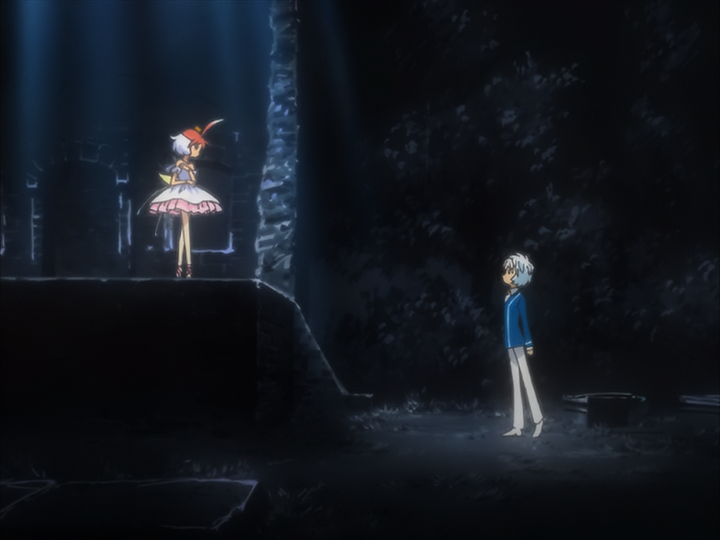
Direction
Moving on we come to Princess Tutu’s direction, and Junichi Satou did a fantastic job here. I mentioned it above briefly, but what really sticks out to me is how Princess Tutu is framed. The entire show is, most of the time at least, framed like a ballet. Every major action scene, and most of the major character scenes, are depicted as if on a stage. The lighting fades and the colors become muted except for around the central characters, giving it the feel of a darkened stage with spotlights. The camera stays on one side of the scene rather than rotating, as if we were watching from our seats. Combined with how ballet permeates the entire show, from subject matter to music choices, this direction helps sell the whole package to the audience. And this is before I get into the more traditional techniques used throughout the series.
I’m of course talking about things like the use of close ups, wide shots, etc. But my personal favorite that Princess Tutu uses to great effect is the extreme-long, or establishing, shots of the city. Throughout the series’s runtime, when transitioning to a new scene, we are given a wide shot of the area, showing us the surrounding streets and where they fit into the town. This not only gives us an idea of where we are, but also helps provide the town a sense of internal consistency. Placing everything in relation to each other, how the city was constructed, and generally providing the town a sense of character. With how important Gold Crown Town is to Princess Tutu’s story, this effect cannot be understated, as by the end, the city is almost as important as our leads. And it would never have worked without the myriad of establishing shots.
That said, I do have some minor quibbles, and these have to do entirely with how Princess Tutu aired. For those not in the know, Princess Tutu’s 2nd cour aired not as 13 30 minute episodes, but rather 26 half length ones so that it could fit its time slot. For the BDs and DVDs this was corrected, merging them back together. But even then, when watching the episodes there is a clear difference in structure between the two halves of the series. Where the 1st was immaculately constructed and paced, the 2nd often feels choppy and repetitive. It makes sense; they had to keep the same story thread going between episodes to fit into 1 “whole” episode. No doubt when watching as it aired, this made for a better viewing experience. Nowadays though it only hurts the series, and we will get more into specifics when we talk story.
Beyond the issues with how it aired though, Princess Tutu also makes odd use of CGI. It tries its hardest, it really does, but things like Drosselmeyer’s gears or some of the environments are just out of place. Occasionally this does work in its favor of course. Drosselmeyer is effectively an otherworldly existence throughout most of the show. And the CGI gears do a good job of placing him outside the rest of Princess Tutu’s world. Additionally, Princess Tutu attempts to insert humor throughout the show to break up some of its more dreary segments. For the most part these are fine, but I have to point out one I particularly hate. For all the good Cat-Sensei does in his role, all his relevant story beats, I cannot stand his marriage jokes. So yes, Princess Tutu has fantastic direction and pacing, and yes it isn’t perfect. I love it anyways.
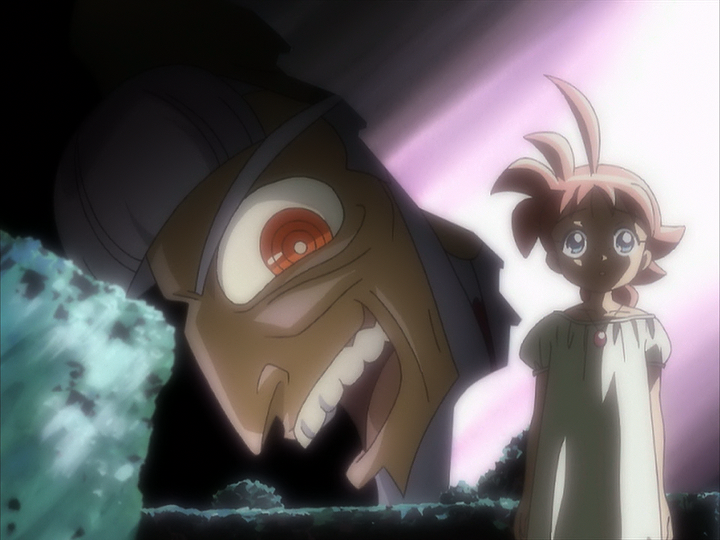
Setting/Story
All that production stuff out of the way, it’s time to talk narrative. At its core, Princess Tutu is pretty simple, a classic “Save the Princess” narrative, except with a Prince. Our lead character Ahiru, a duck, is transformed into a person Fairy-Godmother style and tasked with collecting the shards of the Prince’s heart. Along the way she faces a myriad of troubles, either from those trying to stop her or from the shards themselves. The complexity of it all though comes when you start to consider the why and how for each of these. Why did Drosselmeyer task Ahiru with this, why are Kraehe and Fakir trying to stop her, how did this all come about. In a lot of Mahou Shoujo, you don’t get satisfying answers to these questions. Motivations are often “because they are evil”, etc. But Princess Tutu explains each of these and more.
Take for instance Mytho’s heart shards. Each one is tied to a specific emotion, with a whole episode-long story built around it. Not only does this fit the “monster of the week” nature of the show, but each one tangibly moves the plot forward, as each returned heart shard returns said emotion to Mytho, allowing him to grow and change as a character. There is a clear endgame presented to us from the very beginning, so none of these feel pointless or irrelevant. On top of that, each episodic story is also used to challenge our characters emotionally in some way relating to the shard in question. An episode about affection or love could end up commenting on how stifling that can be if unwanted. Consider more obvious emotions as well, such as pride or fear, and you begin to see just how many themes Princess Tutu can weave in.
The magic of it all though is this: the large amount of episodic themes don’t drown out, but rather augment the overarching ones of defying fate and self-fulfillment. Princess Tutu is framed from the start as a storybook narrative, one with a set ending and even author. From the start Drosselmeyer positions himself not as a character within the story, but the one writing and controlling it. Always addressing Ahiru, Mytho and Fakir as his characters, demanding they do what he says. Getting angry when they try to go against his decided narrative, since what he wants isn’t what they want. As such when the conflict shifts from saving Mytho to breaking free of the story and deciding their own fate, it feels like a very natural progression. This isn’t to say it’s perfect, but what Princess Tutu does right far outweighs what it does wrong.
I mentioned an example of the “wrong” earlier, with the changed air times. Shifting to half-length episodes, while required to air, definitely hurts the pacing and structure of otherwise single episode length stories. Not enough to ruin them, but it is noticeable. And while I love the overall plot and generally enjoyed it, some episodes are better written than others. It’s in these cases that the episodic nature can hurt it a bit, since a bad “monster of the week” episode is just that, a bad episode. One such example of this was Episode 16, Maiden’s Prayer, which felt like it was just retreading old ground in the show. It didn’t feel like it progressed all that much. That said, these are few and far between, and I generally loved my experience. For what is on the surface just another vapid Mahou Shoujo, Princess Tutu is incredibly, beautifully complex.
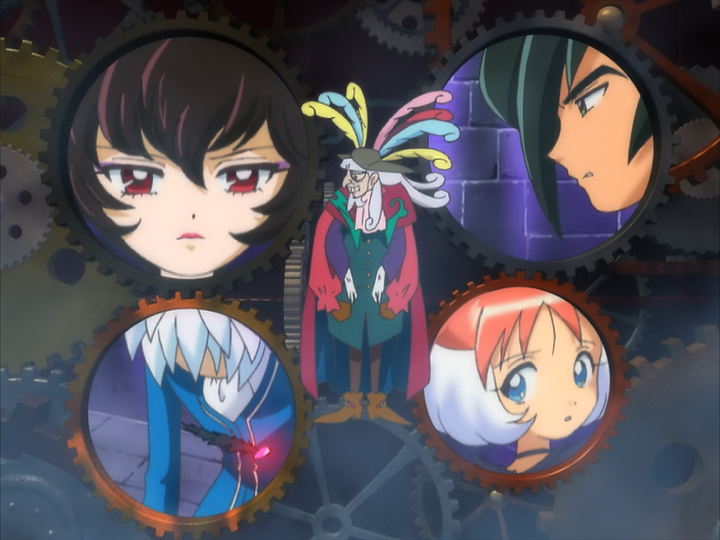
Characters
Now we can get to what I really want to talk about, the characters. Oh how I love the characters. The whole cast is one of the most emotionally complex and engaging I have seen in a long time. Take for instance our lead, Ahiru, who spends most of the series in conflict with herself. From the beginning she sees Ahiru and Tutu as two separate people. One the clumsy duck, the other her idealized self who she grows into over the course of the series. By the end, she comes to accept that the two are one and the same. That she does have worth and she does matter, as more than a character in everyone else’s story. All the while working to recover the shards of Mytho’s heart. With this young crush on Mytho transforming and realizing into an actual emotionally mature relationship by the end.
Ahiru’s is not the only arc Princess Tutu has progressing at any one time, with Rue’s being a personal favorite. Where Ahiru is childish and clumsy, Rue is mature and elegant. She is everything Ahiru wishes to be, even being in a relationship with Mytho herself. But over the course of the story we are shown that not all is right, even in Rue’s seemingly perfect world. We have a tale of abuse and love, of how children regard their parents and the damage a poor parent can have on a child’s mentality. Princess Tutu shows us how a character can have everything they want, yet still not be happy, because it wasn’t what they needed. All the while fitting both these, and other stories, into a greater narrative about fate and writing your own story rather than simply accepting someone else’s.
I could go on and on about these characters. Dancing around heavy spoilers, going in on characters like Fakir and Drosselmeyer or how beautiful Mytho’s emotionless character slowly regaining said emotions is. At the end of the day though, without outright spoiling some of the greatest and most impactful plot points of the series, all I can do is speak in vague generalities. And I am not a good enough writer to make that interesting or informative. So the best you are going to get here is this: I think Princess Tutu’s cast is one of the best in anime. Their stories, how they intertwine and relate to each other and the greater narrative at large, are fantastic. If you want specifics, I have write ups on every episode at the same site I linked above. Otherwise, just watch the show again and you’ll get it.
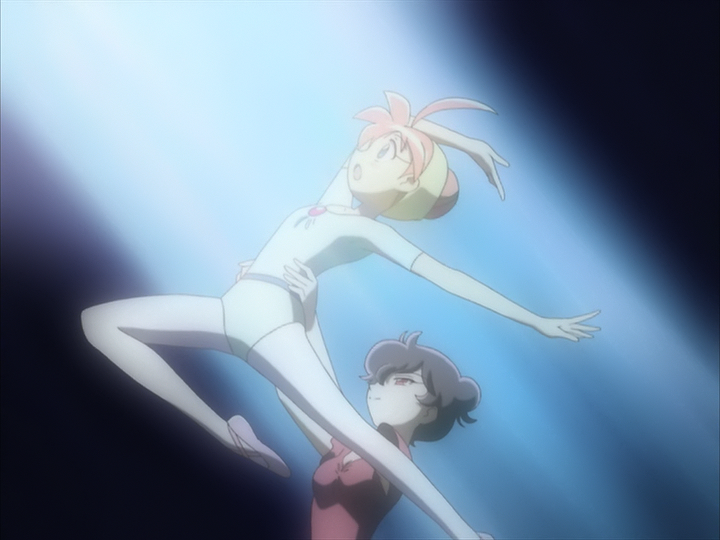
OST/Sound Design
Finally we come to the last real section of this review before a personal anecdote, the OST. This is actually a rather weird one to judge. Because on one hand, who would have guessed, classical music is fantastic. On the other hand though, very little of Princess Tutu’s OST is unique or made for the show itself. How fair is it to judge a show for taking great music from outside, and just shoving it in? Well when you shove it in as well as Princess Tutu does, I don’t see anything wrong with giving them credit where it’s due. Because Princess Tutu takes these songs, some almost 200 years old, understands them and then uses them where they have the greatest effect. Taking songs that already have meaning outside of the series, and bringing that meaning into the anime to augment each of its own scenes.
To be clear, I’m no classical expert, I’m just some dude on the internet. But I do enjoy going to the symphony now and again, allowing me to understand and appreciate a few of Princess Tutu’s choices. Take for instance the “Dance of the Sugar Plum Fairy” from Tchaikovsky’s The Nutcracker. In the ballet, this is played after the Prince and Princess return together, a culmination of their journey. In Princess Tutu this acts as Mytho’s theme, and we see him dancing to it quite a bit. Considering the haunting nature of the music, and Ahiru’s own goal of restoring the Mytho’s heart, “returning” him to the Prince, you can see why it fits so well. In fact Princess Tutu uses quite a few songs from The Nutcracker, such as “Waltz of the Flowers” and “Marche“. With how similar the works are, I think its a good fit.
Another example is “Gymnopédies 1” by Erik Satie. A fitting and sad tune for a character like Rue, it’s history also mirrors hers. To this day, we don’t know the meaning of this song and its history is in question. Was it based on a poem? Or did the poem come after? Was it inspired by a painting, or does it have some personal meaning to the composer? Like Rue, its history is in question, and it has floated around as background music in other people’s stories for ages. These two pieces are far from being alone however. Fakir and the “Coriolan Overture” or Edel and “Musique des automates“. Some of these fit better than others, while others connect in name only. However there was never a piece that took me out of the moment. And the more I learned about each one the more I loved its inclusion.
All in all, Princess Tutu may not have a 100% original OST. But what it does have is one of the most fitting and symbolic OST’s I have had the pleasure of listening to. Whatever meaning an anime may want to embed into a scene, it’s hard to top the decades of meaning behind every piece used here, when they are used well. And Princess Tutu does just that.
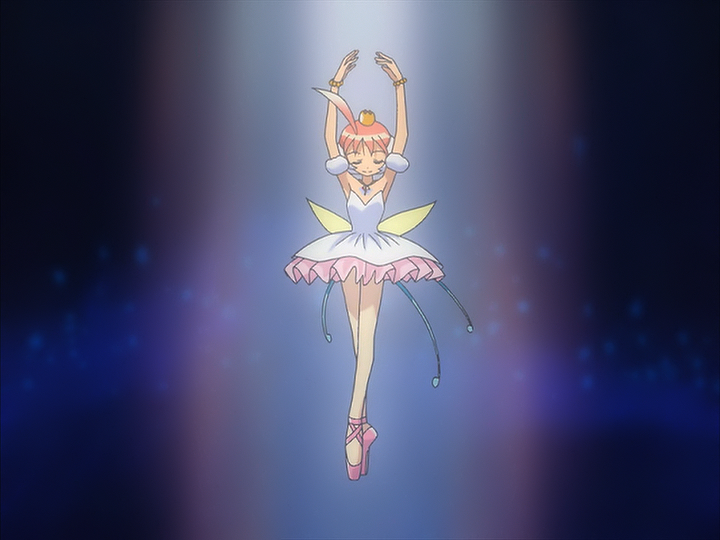
On Magical Girl Shows
Now we come to a more personal section of this review. This bit here isn’t particularly relevant to the series as a whole, nor does it affect the final score. This is more about my experience with Mahou Shoujo, and is for those on the fence about it like I was. I want to explain why I don’t like Mahou Shoujo and just what sets Princess Tutu apart from the rest. If you already like Mahou Shoujo or don’t care, feel free to skip to the bottom. But if you are unsure or want to listen to why an action junkie loves what is ostensibly a kids show, then strap in.
Now, as I said above, I tend to dislike Mahou Shoujo for two main reasons. Either they are diabetes-inducingly sweet or they try so hard to be something more, they become incomprehensible. In the first group is where you will find your Precures, like Hugtto or Star Twinkle. I can’t speak for the entire franchise since the only one I have actually finished is Hugtto, and that under duress. But those two didn’t leave me with the best taste. I just wasn’t able to care about the conflict or characters in these shows. I found them to be shallow and dull. And while the production was often fantastic, say what you will about Hugtto but it looks great, it just wasn’t for me. The characters felt over-designed and garishly bright, pushing the sweetness to teeth-rotting levels. Simply put, they were well made, but just not for me.
On the incomprehensible end are works like Penguindrum and basically anything Ikuhara directs. The man is a fantastic director, his shows are visually great. But as a storyteller I can’t help but think he throws everything he can into his series, without any concern for how they fit together. The result is often an incomprehensible mess that viewers dig into and create their own meaning out of. If that’s for you, great, don’t let anyone tell you that you can’t enjoy his works. But for me it always came across as a disjointed mess, ruining whatever narrative vision or social commentary could have been behind it. When the man himself can’t or won’t explain any of his intent behind the works, “leaving it to the audience”, I am inclined to think he doesn’t know himself. So, if I detest Mahou Shoujo so much, why do I love Princess Tutu?
If I had to nail it down to one thing, one reason why Princess Tutu clicked with me… it would be tone. The tone of Princess Tutu is like no other Mahou Shoujo I have seen before. It is simultaneously sweet, as you would expect from the genre, but with hints of tragedy spread throughout. There isn’t a single facet of this show without some darker shade to it. Yet unlike series such as Madoka Magica, this darkness isn’t suffocating. It’s this juxtaposition of tragedy and hope that really draws me into Princess Tutu like no other Mahou Shoujo. Whether it be the fairy tales brought in, with a Brother’s Grimm-esc twist, or the comedy, with a dash of sadism. A teacher who jokes about marriage, only to then use those jokes as commentary on what it means to be in love. Princess Tutu isn’t perfect, but it is unique.
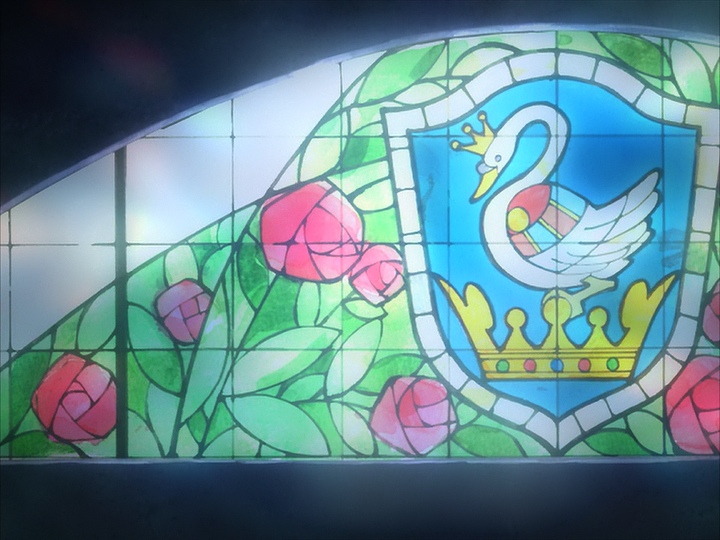
Conclusion
And here we are at the end, only took me 3700 words. I really need to learn to tone it down, but I also really liked Princess Tutu. All in all, for all its faults from pacing to some poor jokes to the occasional filler episode, I love it. Princess Tutu is without a doubt worth your time, regardless of how you feel about the genre. If you like traditional Mahou Shoujo, the core of the genre is still there. If you detest it, I believe Princess Tutu is just unique enough to challenge that. At the end of the day, as cliche as it is to say, I think everyone can find something to love in this show. And I think everyone should watch it at some point, if only to listen to some fantastic music.
And that’s a wrap! Thanks for reading, the next series we will be watching, winning by 1 vote, is 2003’s Gunslinger Girl S1, starting on June 25th! It’s 13 episodes, so we will be doing 1 a week. I hope you are looking forward to it, because I know I am.

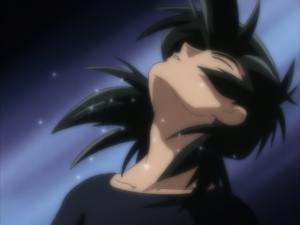
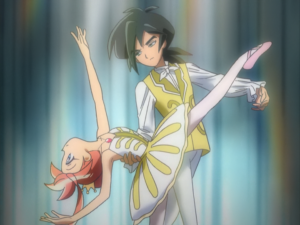
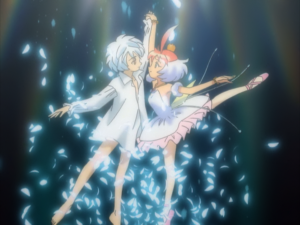
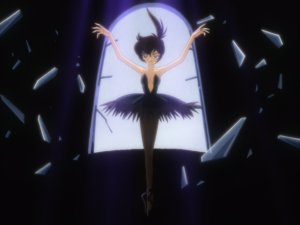
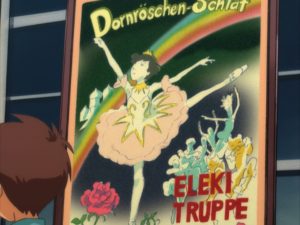
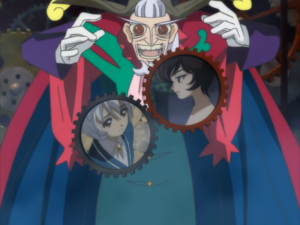
It’s totally understandable if magical girls aren’t your thing. Everyone has different tastes is all. I haven’t seen every Precure season myself, though I can tell you that some seasons are much better than others (Heartcatch, Suite, Go Princess, and Splash Star are my favorites. Avoid Happiness Charge and Yes! Precure 5 like the plague, as both are the terribly generic, uninspired kind that you hate so much. But again, your mileage may vary). I personally like mine with a little more substance to them, like Fancy Lala, which is my all-time favorite, and Psgels did talk about it here. It’s been years since I saw Princess Tutu, and I really ought to rewatch it and review it some time myself, as I do remember really liking it and still own the DVD boxset. Speaking of magical girl stuff, I recently discovered a webcomic called Sleepless Domain, which is kind of like Madoka Magica in terms of its tone and having a dark twist very early on, but has the right balance of sweet/hopeful/tragedy like you feel Princess Tutu does, and its main plot is kind of a mystery/adventure story like Magia Record. If you want, you can read it here: https://www.sleeplessdomain.com/comic/archive
And yay, Gunslinger Girl won the vote! I still have my FUNimation DVDs for those, and again, that’s another show I need to revisit. Maybe I will this year, since COVID kinda delayed a bunch of newer shows, and most of what’s airing doesn’t interest me aside from Arte.
I’ll check it out! If nothing else, Princess Tutu has made me more willing to give things in the genre a shot. I still doubt I will like most of them, but I am much more open to giving them a shot now.
Also, I don’t know if you already checked this out or not (I know somebody did a first impressions of it), but whatever you do, DO NOT check out Magical Girl Site (Mahou Shoujo Site). People thought Madoka Magica was grimdark, but Magical Girl Site absolutely embodies all of the criticisms haters throw against Madoka Magica and more. It’s beyond awful, and tries way too hard to be as viscerally dark and edgy and violent as possible.
I’ve heard of it, and what I did really turned me off. Things like razor blades in shoes in lockers, and just over the top edgy crap. Madoka was much more… philosophically dark, with Witches and Kyubei and all that jazz. Site just sounds like it was written by a 14 year old though.
Yeah, I chucked it when the show decided that having girls pay a guy to rape another girl wasn’t considered going too far, but somehow attacking with her with a knife is. Priorities! Am I right? Ugh.